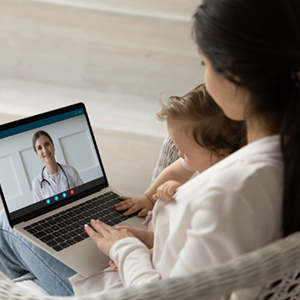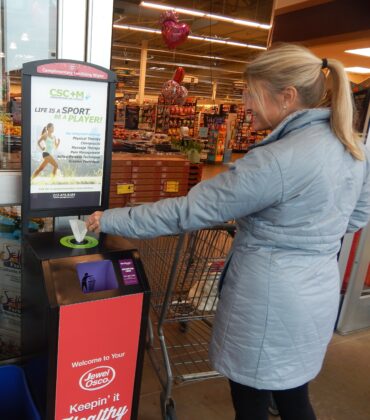With the worst of the COVID-19 pandemic over, patients are returning to in-person appointments.
However, the pandemic increased awareness of the benefits and utility of telehealth appointments, and studies have shown that telehealth utilization has stabilized at levels 38X higher than before the pandemic.
Since consumers are looking for virtual health appointments now more than ever, let’s break down the most effective advertising strategies to reach and convert them.
How To Advertise Your Telehealth Practice
Understand Your Target Audience
The first step to any successful marketing campaign is to fully understand your target audience. With an accurate view of your primary audience, you can develop your marketing material around their pain points and how your telehealth services uniquely solve them.
The target audience makeup for telehealth services varies depending on treatment specialties and marketing campaign goals. With that being said, these are some of the groups most known to rely on telemedicine:
- Parents and caregivers: It’s often difficult for parents to leave the house when caring for children. So, telehealth appointments are a solution that allows caregivers and their children to check in with their doctors from the comfort of their homes.
- Seniors: The pandemic heightened concerns among the elderly about getting infected during in-person doctor appointments. Telehealth consultations allow older adults to receive routine checkups, medication management, and chronic disease management without the stress of being exposed to an illness.
- Underserved communities: These communities could be isolated rural areas or impoverished inner-city neighborhoods. Telehealth services have been shown to massively increase access to healthcare in these communities.
- Frequent travelers: People who frequently travel to other countries or live abroad appreciate virtual access to doctors from their home country who accept their insurance.
Improve Your Website
Since telehealth services rely on digital tools to connect with patients, you can’t afford to have an out-of-date website. 76% of US adults use smartphones to search for services, so making your website friendly to desktop and mobile users is an essential aspect of improving your online presence. But it isn’t the only one.
If you are a medical practice looking to expand into telemedicine, be sure to update your homepage with information about telemedicine and create a landing page specifically for those services. It’s also a good idea to prominently feature reviews and testimonials from patients who used your virtual services since this will establish trust and credibility with prospective patients.
Aside from this content, many telehealth providers use a suite of digital tools to attract and convert prospective patients. These digital tools can include things like interactive symptom checkers or virtual tours of your in-person facilities.
Use Paid Advertising
Online Advertising
After polishing up your website, it’s time to drive traffic to it. Google is the most used search engine by far, and effective advertising on the platform can have a big impact.
With Google Ads, you can pay to have your telehealth brand featured in the top three search results for keywords of your choosing, such as “telehealth pediatric consultations”. This medium also allows you to use ad extensions to provide information like your clinic’s contact number or patient reviews.
Google Ads are pay-per-click, meaning that advertisers only have to pay when a user clicks through their sponsored link. So, you’ll only have to pay when a prospective client engages with your brand, but bidding for highly sought-after keywords can reach as high as $80 per click.
Out-of-home advertising: Wellness Boards
When most marketers consider out-of-home (OOH) advertising, they think of highway billboards, transit signage, and other physical displays. While these advertising mediums can boost brand awareness among the general public, they are incapable of tracking engagements and targeting consumer groups.
Fortunately for telehealth marketers, wellness boards are an OOH advertising that can solve these problems and provide a perfect contextual setting for prospective patients to resonate with your brand.
Wellness boards dispense sanitizing wipes from below a prominently featured advertisement and are often placed in the pharmacy wait areas of stores like Walgreens and CVS. Pharmacy wait areas are optimal advertising real estate for any healthcare brand because consumers associate these promotions with the medication and pharmacist they trust.
Additionally, wellness boards can be equipped with digital tools to effectively track engagements and reach target audiences. Wellness boards with retargeting and geofencing capabilities utilize the anonymized mobile data of nearby shoppers to analyze interactions with the advertisement. With this mobile data, you can send preprogrammed advertisements to shoppers who viewed your physical display– making it easy to synergize your online and offline advertising efforts.
Terraboost is an innovator in this advertising medium and independent studies have shown that 80% of shoppers engage with their sanitizing kiosks and that 50% would take a coupon or brochure to learn more about the sponsored company.
Leverage Social Media
Like any good marketer, your goal should be to reach consumers where they are, and that’s increasingly on social media platforms. In fact, Americans use social media for approximately two and a half hours each day.
Social media platforms are in the data collection business, meaning they give advertisers access to key consumer data points on things like user location, interests, search history, and age. With all that information, telemedicine brands using paid social media marketing can guarantee that their ads will appear in the social media feeds of their target demographic.
Paid social media advertising can be useful, but many believe the market is oversaturated with 74% of consumers having a negative opinion of them. That’s why many telemedicine companies simply focus on maintaining active social media accounts that can drive organic growth.
Operating an active social media account can provide your existing clients with another touchpoint to interact with your brand and let prospective patients get an inside look at your practice.
Healthcare companies on social media tend to rely on patient testimonial posts, and for good reason. Patient testimonials are one of the best ways to appeal to prospective patients and encourage them to place trust in your brand. It’s best to post a series of testimonials featuring patients of diverse backgrounds who discuss how your telehealth services improved their quality of life.
Your posts can also include informational content, such as quick health tip videos or a step-by-step on how a typical telehealth consultation works. Another great way to engage with existing and potential patients is to host Q&A sessions on platforms like Facebook Live and Instagram. During these live sessions, you can address common telehealth questions and direct users to your services.
Search Engine Optimization (SEO)
A stunning 86% of consumers use Google Maps to search for local products and services. That means it’s essential for any business, including those in telehealth, to fully utilize the platform.
The first step to conducting local search engine optimization (SEO) is to create a Google My Business Account and claim your listing. You’ll want to include information like your business address, operating hours, and number because Google ranks businesses with up-to-date profiles more highly.
One of the most important criteria for Google Maps rankings is the number of 4- and 5-star reviews your business has received online. In addition to reviews on their own platform, Google takes into account reviews from other sites like Yelp, Healthgrades, and RateMDs. You can certainly drive 5-star reviews from good service, but it can be more effective to actively solicit your patient base for reviews.
Articles and blogs on local issues can also boost your rankings in regional search listings. The best way to do this is to write about health issues specific to your geographic region, such as “Combating Allergies in Austin: A Telehealth Guide”. It’s important to perform keyword research prior to writing these articles so that you can include phases that potential patients are most likely to search. These phases could include things like “telehealth services for anxiety” or “online doctor”.
Create Educational Content
Educational content is the centerpiece of many digital marketing strategies in the healthcare industry. That’s because 70% of Americans consult the internet to search for health information and diagnose themselves. So, when people search for healthcare questions in your area of expertise, your content should provide answers and encourage them to schedule a consultation.
Educational content that is packed with credible information can drive online traffic to your telehealth practice because it is likely to be shared among health-conscious consumers. However, you can further boost the visibility of this content by performing SEO keyword research for each topic you write about.
What’s great about publishing educational content is that Google gives preferred search listing spots to healthcare brands they perceive to have Expertise, Authoritativeness, and Trustworthiness (E-A-T). So, by creating informational content, Google will regard you as a public educator and reward you for it.
Set Up Email Marketing Campaigns
Email marketing for telehealth practices can provide another meaningful contact point to connect with prospective and current patients.
Successful email marketing campaigns focus on sending personalized messages to relevant patient groups. When trying to convert new customers, your emails should include things like seasonal discounts and detailed treatment options.
For current patients, you should carefully segment email lists based on factors like appointment history, illnesses, and demographics. By doing so, you can send emails specified for each group that are more likely to be opened and appreciated. For example, you could distribute various monthly newsletters that focus on issues specific to your different patient groups.
Segmented email lists also make it easy to set up automated campaigns that send out new patient greetings, appointment follow-ups, and scheduling reminders.
Collaborate And Engage With Other Professionals
Partnerships and collaborations with other healthcare-related businesses are a fantastic way for telehealth practices to expand their reach. The following is a list of some of the most effective partnerships for telehealth businesses.
- Physician Referral Programs: Through a referral program, you can encourage in-person physicians to use your telehealth services for remote consultations and follow-up care.
- Specialist Partnerships: Telehealth companies can quickly expand their service offerings by partnering with specialists like psychiatrists, dermatologists, and cardiologists.
- Co-host Webinars: Hosting webinars with a specialist in a complementary field will help grow your network and establish your credibility
Deploying a successful telehealth marketing campaign can be difficult, but it doesn’t have to be. We at Terraboost have worked with countless healthcare brands and can provide you with key industry insights as well as a free personalized quote.
Our 120,000+ wellness boards are featured in the pharmacies of stores like CVS, Walgreens, and Rite Aid and deliver up to 8.8 billion monthly engagements!
If you are looking to utilize one of the most effective OOH advertising mediums, get in touch with us today!



